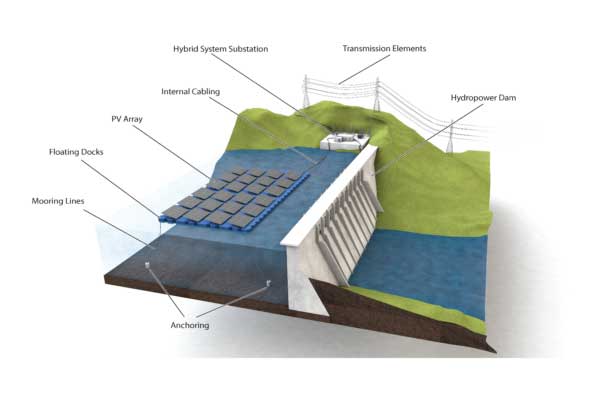Examining Floating Photovoltaics: A Novel Evaluation Tool
Floating photovoltaics (FPV) tool will help deploy more solar power generation systems on reservoirs.
 The United States has roughly 26,000 reservoirs of various sizes, totaling 25,000 square miles of water. A new study suggests that covering 30% of U.S. reservoir area with floating panels could generate 1,900 terawatt-hours of energy and save 5.5 trillion gallons of water annually from evaporation. For comparison, a 500-megawatt coal power plant generates about 3 terawatt-hours of energy per year. That’s only 1/600th of floating PV power potential. The U.S. Department of Energy’s Idaho National Laboratory (INL) and National Renewable Energy Laboratory (NREL) are collaborating to create a tool to help developers evaluate reservoirs and estuaries where FPV panels could enhance local energy systems.
The United States has roughly 26,000 reservoirs of various sizes, totaling 25,000 square miles of water. A new study suggests that covering 30% of U.S. reservoir area with floating panels could generate 1,900 terawatt-hours of energy and save 5.5 trillion gallons of water annually from evaporation. For comparison, a 500-megawatt coal power plant generates about 3 terawatt-hours of energy per year. That’s only 1/600th of floating PV power potential. The U.S. Department of Energy’s Idaho National Laboratory (INL) and National Renewable Energy Laboratory (NREL) are collaborating to create a tool to help developers evaluate reservoirs and estuaries where FPV panels could enhance local energy systems.
While more common in Southeast Asia and Europe, where open spaces are limited, FPV panels on reservoirs, estuaries and other bodies of water is increasing in popularity in the United States for several reasons:
- Minimal land footprint: FPV systems reduce the need for large areas of land to house and operate solar panels.
- Greater efficiency: FPV systems deliver enhanced performance over ground-based PV due to the cooling effect of the water.
- Resilience: Studies have shown that hydroelectric dams operating in conjunction with FPV systems can optimize energy efficiency and improve system reliability.
- Water conservation: FPV systems have the potential to reduce evaporative losses substantially, with vital water savings for drought-stricken areas.
The World Bank reported FPV has a global capacity potential of 400 gigawatts. Before widespread adoption can occur, however, researchers need to better understand FPV’s possible impacts. INL and NREL are creating an FPV evaluation tool, AquaPV, that will evaluate:
- Technical and economic feasibility (INL with support from DNV)
- Potential environmental impacts (INL with support from Oregon State University)
- National potential for power production (NREL)
In addition, the project will inform stakeholders about regulatory pathways for FPV deployment in U.S. reservoirs. NREL is conducting this work.
Evaluation tools
The energy industry is interested in FPV but perceives potential risks due to potential environment, safety, and health impacts and the lack of tailored techno-economic analysis tools. This project published the online toolset AquaPV to support stakeholders such as solar developers, hydropower operators, state agencies and NGOs in evaluating the benefits and potential impacts of FPV in federal regulated reservoirs.
The tool has three main modules: a capital expenditure (CAPEX) estimator tool, a techno-economic analysis tool with options to include federal incentives and the environmental analysis module of the tool which helps users understand potential environmental interactions, improving decisions on permitting and licensing.
Case studies
INL is working closely with two utility partners to design and evaluate FPV conceptualizations in two projects:
- The Cat Creek energy & water project is part of the planning stages of a major pumped storage and renewable energy generation project in Elmore County, Idaho, on the South Fork of the Boise River. The project will use the U.S. Bureau of Reclamation’s Anderson Ranch Reservoir as its lower reservoir and excavate an upper reservoir on private ranch land to support 720 megawatts of pumped storage hydropower. Planners anticipate using on- and off-site wind and solar, including 110 MW of FPVs on a new reservoir south of Anderson Ranch Reservoir, to power the pump that moves water from the lower to the upper reservoir during times of off-peak demand.
- The Yadkin River hydroelectric project in the Tuckertown reservoir is one of four hydroelectric stations on the Yadkin River about 75 miles outside Charlotte, North Carolina. INL is working with Eagle Creek Renewable Energy on an FPV concept to explore the benefits of a hybrid power plant that combines hydropower and FPV.
